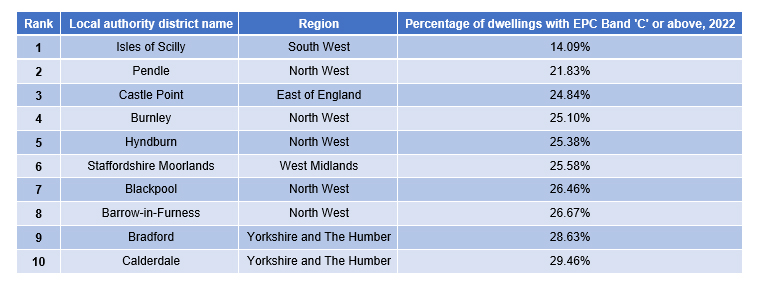Recent findings reveal the areas in England with the lowest energy efficiency ratings, with the Isles of Scilly identified as having the least energy-efficient homes.
Research conducted by Enviro Homes Renewables, using data from the Office for National Statistics, has highlighted the areas with the poorest energy performance in England. The study focused on the percentage of homes within each local authority that have achieved an Energy Performance Certificate (EPC) of Band ‘C’ or above. The Isles of Scilly recorded the lowest percentage, with only 14.09% of homes reaching Band ‘C’ or above in 2022, marking a significant disparity in energy efficiency.
Regional Analysis
Following the Isles of Scilly, Pendle in Lancashire and Castle Point in Essex ranked second and third for having the least energy-efficient homes. Pendle reported 21.83% of homes with at least a Band ‘C’ rating, while Castle Point had slightly more at 24.84%. Other areas like Burnley and Hyndburn, also in Lancashire, featured prominently on the list, underscoring a regional trend of low energy efficiency.
The top ten England areas with the least energy-efficient homes
Addressing the Efficiency Gap
Ross Jones, Director of Enviro Homes Renewables, commented on the implications of the findings: “While there are many ways you can save money on energy for your home, having a low energy efficiency rating can make this very difficult from the start, and costs will add up, and with the current cost of living this can be a serious problem.” He suggested that residents in these areas could enhance their EPC ratings through various improvements such as installing insulation, upgrading lighting, and replacing old boilers.
The study’s results not only highlight the regions struggling with energy efficiency but also emphasize the broader implications of these inefficiencies on cost of living and environmental impact. This data provides a critical insight into the ongoing challenges and potential strategies for improving energy performance across English homes.







